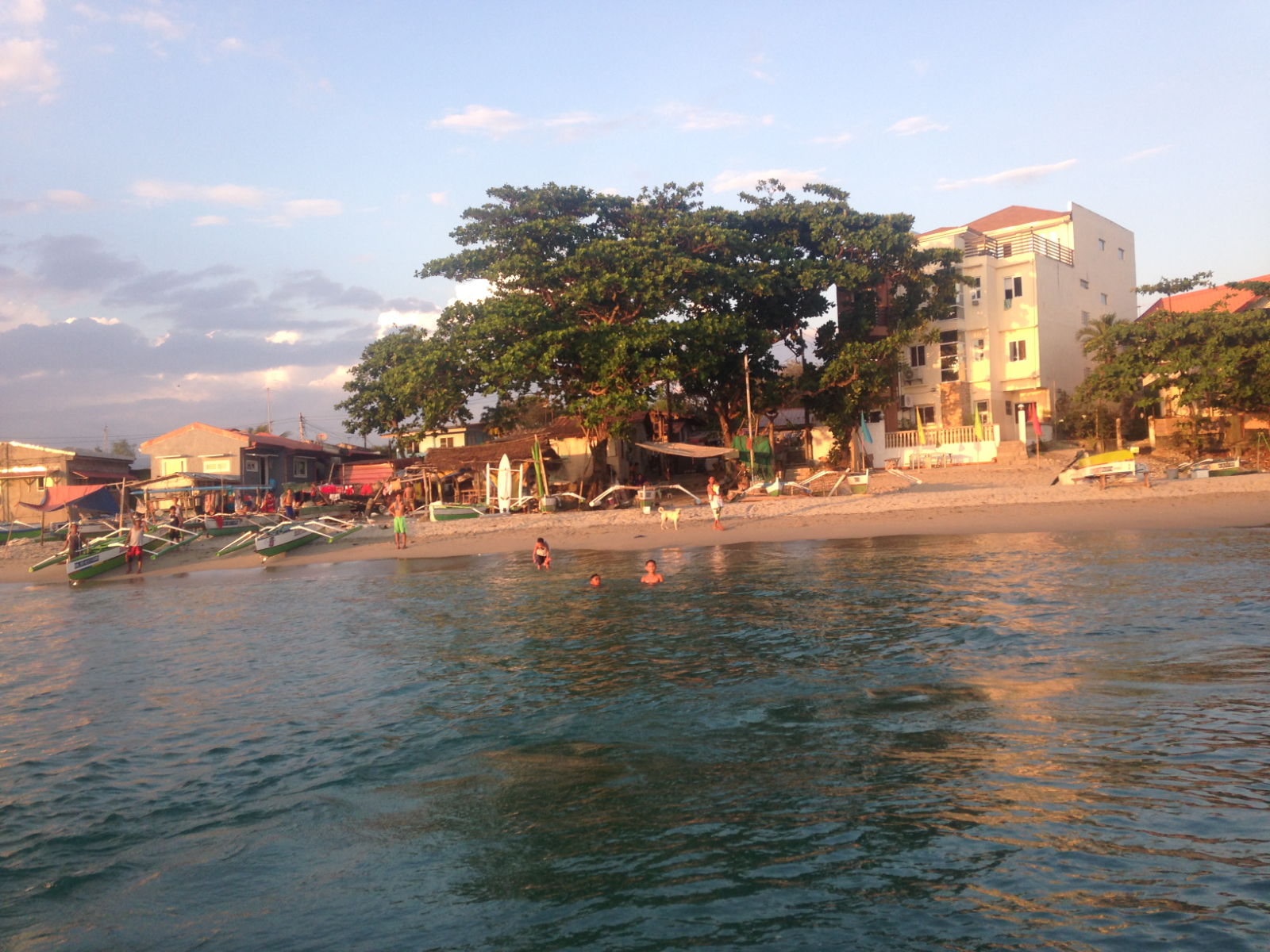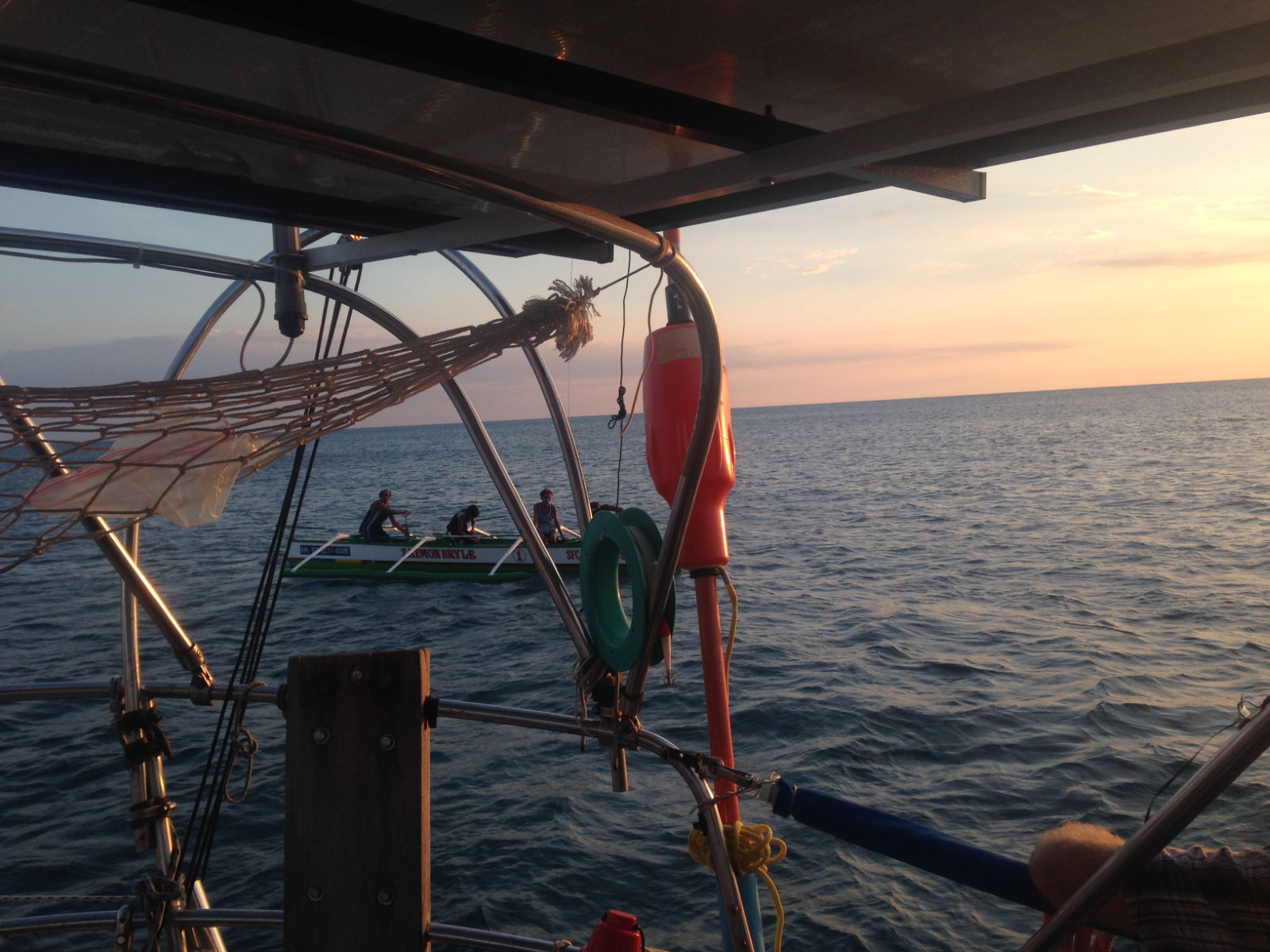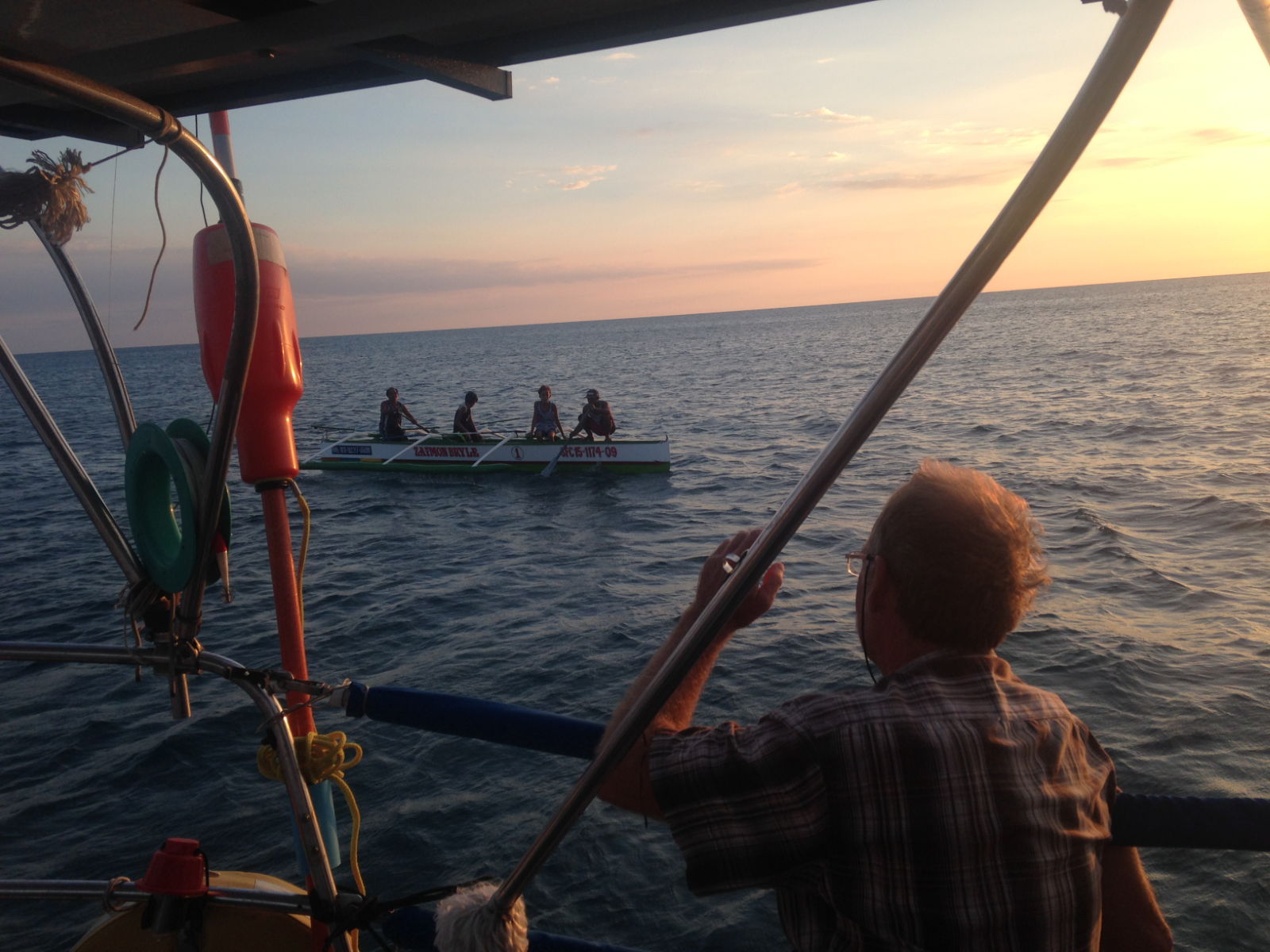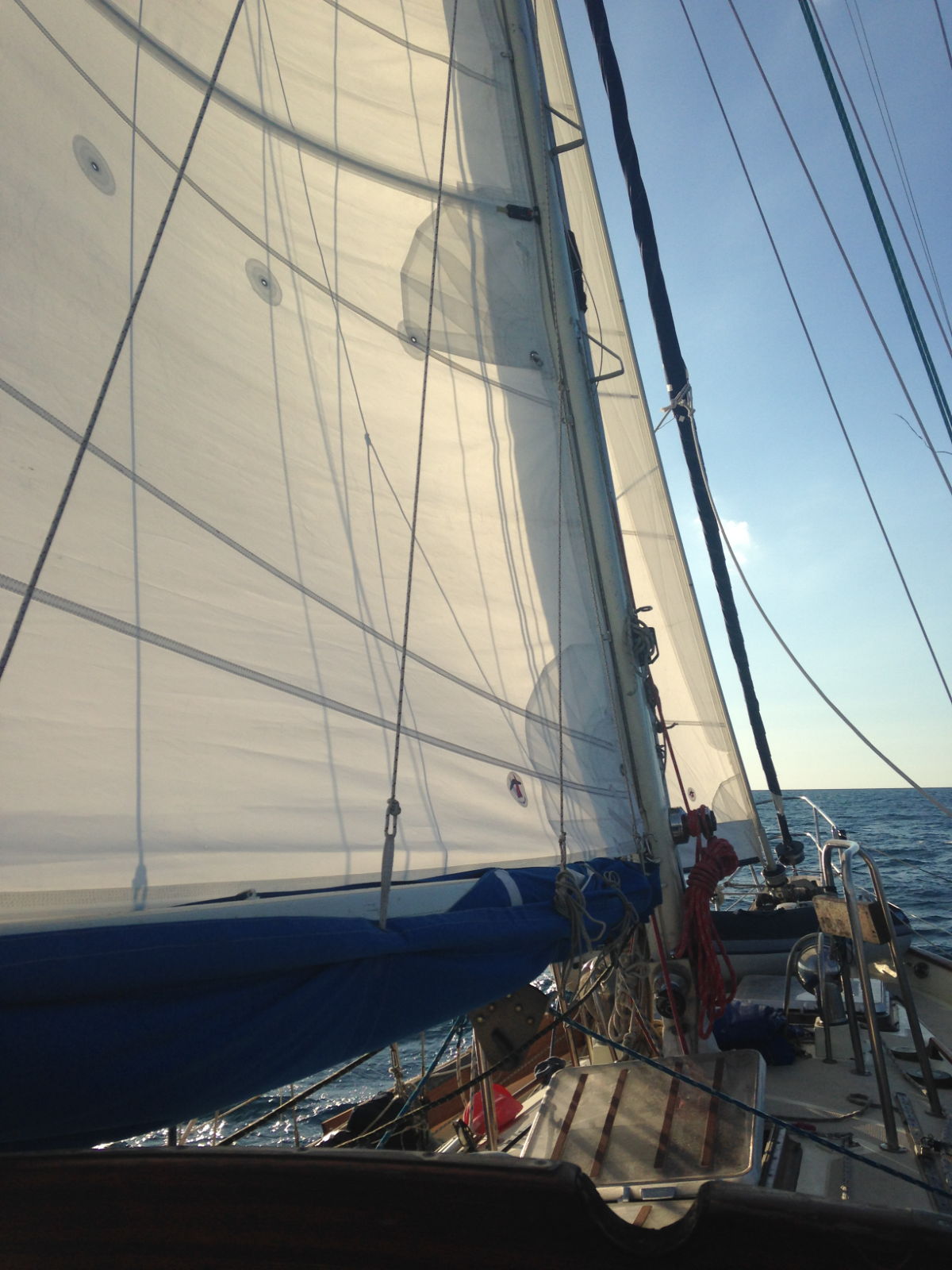At 9am on Thursday 5th April we slipped our mooring at Puerto Galera. The wind behind the main and head sails was soon propelling us along, but for the first time Paul had to use the spinnaker pole to stabilise the headsail: often a precarious and finicky job, especially in rough weather when the boat is rolling. It was great to be free from the noise of the engine but in the busy shipping lane we had to cross, the VHF radio was continually relaying interaction between vessels and the port authorities in Batangas. Interference makes the stations crackle loudly, and when impatient captains repeat the same requests over and over, it can be an assault on the ears, but it petered out as we drew away from the Batangas area. During the afternoon the wind dropped and slowed our progress considerably, but for once it was a positive thing because due to a slight miscalculation, we would have been arriving at our destination in the early hours of the morning at the speed we’d been making. A few hours delay would hopefully have us there at the more convenient hour of sunrise instead.
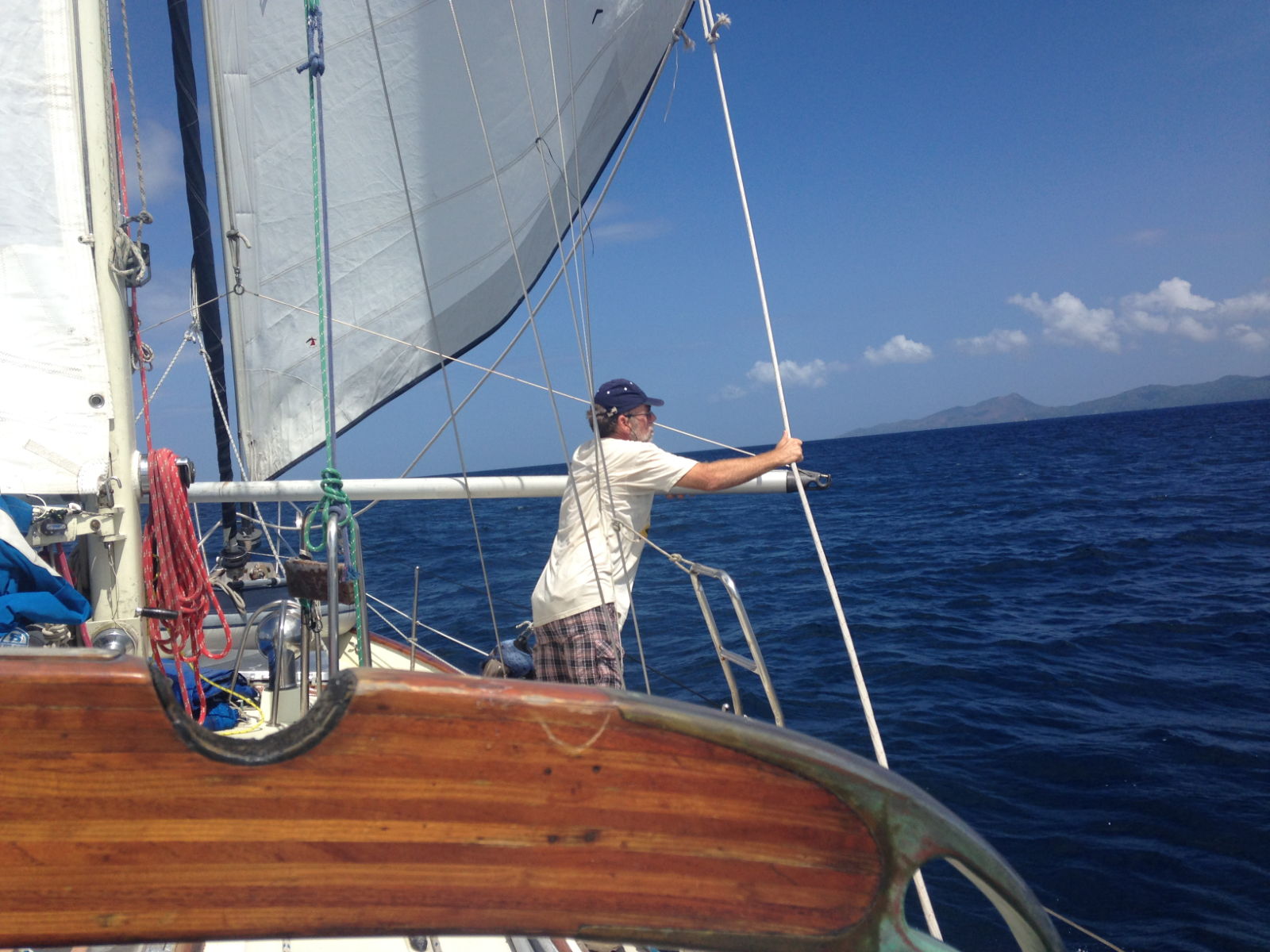

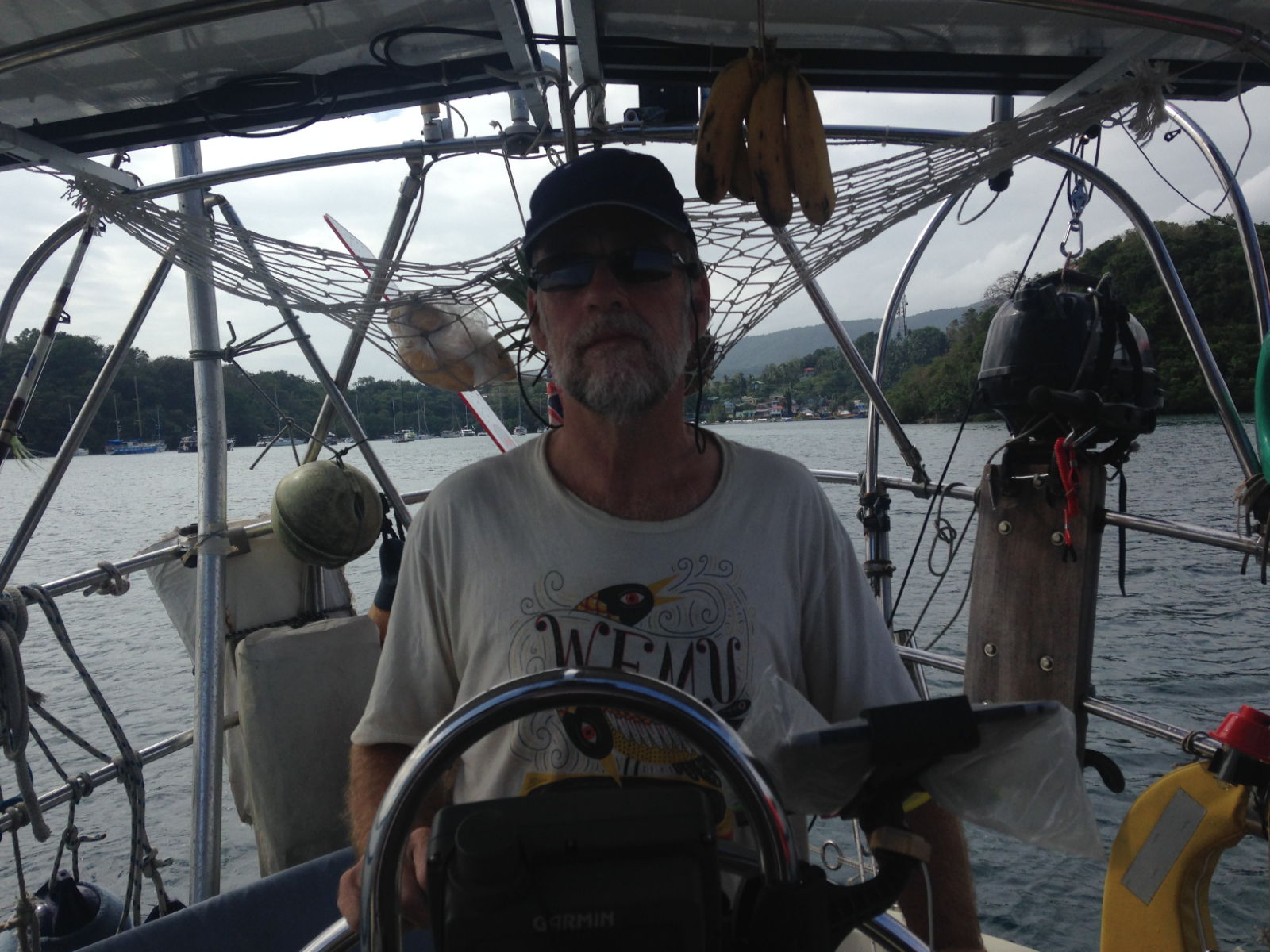 The shipping lane near Manila had us negotiating our way around huge cargo and container vessels, but the AIS provided reassurance about collision likelihood. The other benefit of going slowly under sail was the huge saving on the amount of fuel we used, but best of all, no engine means no danger of fishing nets getting caught in the propeller. As darkness fell, more fishing boats appeared and we had to manoeuvre around them. One of the crew on a boat on our starboard side got quite agitated. He shone his torch at our boat in a sweeping motion, then pointed it on the surface of the water. He probably couldn’t tell we had no engine on, but we could only guess he was worried about his nets. It was unnerving not to be sure he wasn’t alerting us about some unseen peril we were heading for, but that’s probably more to do with my overactive imagination 😉 After a dinner of veggie burgers and fried onions in buns (great al fresco fare), we began the night watch. I took the 8 until midnight one and for the first time, felt chilly enough to put a coat on. By the time Paul took over a few hours later, we were almost there. I had intended to stay awake to help with anchoring but I woke to the sound of the anchor being dropped at 3am. Paul had decided we could wait in Benanga Bay and catch up on some sleep so that we could find the marina in daylight.
The shipping lane near Manila had us negotiating our way around huge cargo and container vessels, but the AIS provided reassurance about collision likelihood. The other benefit of going slowly under sail was the huge saving on the amount of fuel we used, but best of all, no engine means no danger of fishing nets getting caught in the propeller. As darkness fell, more fishing boats appeared and we had to manoeuvre around them. One of the crew on a boat on our starboard side got quite agitated. He shone his torch at our boat in a sweeping motion, then pointed it on the surface of the water. He probably couldn’t tell we had no engine on, but we could only guess he was worried about his nets. It was unnerving not to be sure he wasn’t alerting us about some unseen peril we were heading for, but that’s probably more to do with my overactive imagination 😉 After a dinner of veggie burgers and fried onions in buns (great al fresco fare), we began the night watch. I took the 8 until midnight one and for the first time, felt chilly enough to put a coat on. By the time Paul took over a few hours later, we were almost there. I had intended to stay awake to help with anchoring but I woke to the sound of the anchor being dropped at 3am. Paul had decided we could wait in Benanga Bay and catch up on some sleep so that we could find the marina in daylight.

It was a glorious morning to set off in a few hours later. There were the usual things to look out for, such as fishing markers, nets and boats and it was pleasant to stand on the side deck to watch for them with a cup of hot coffee in the warm, gentle breeze. We passed some picturesque views, all of which were interspersed with industrial sites of shipbuilding yards, dry docks, and construction sites.
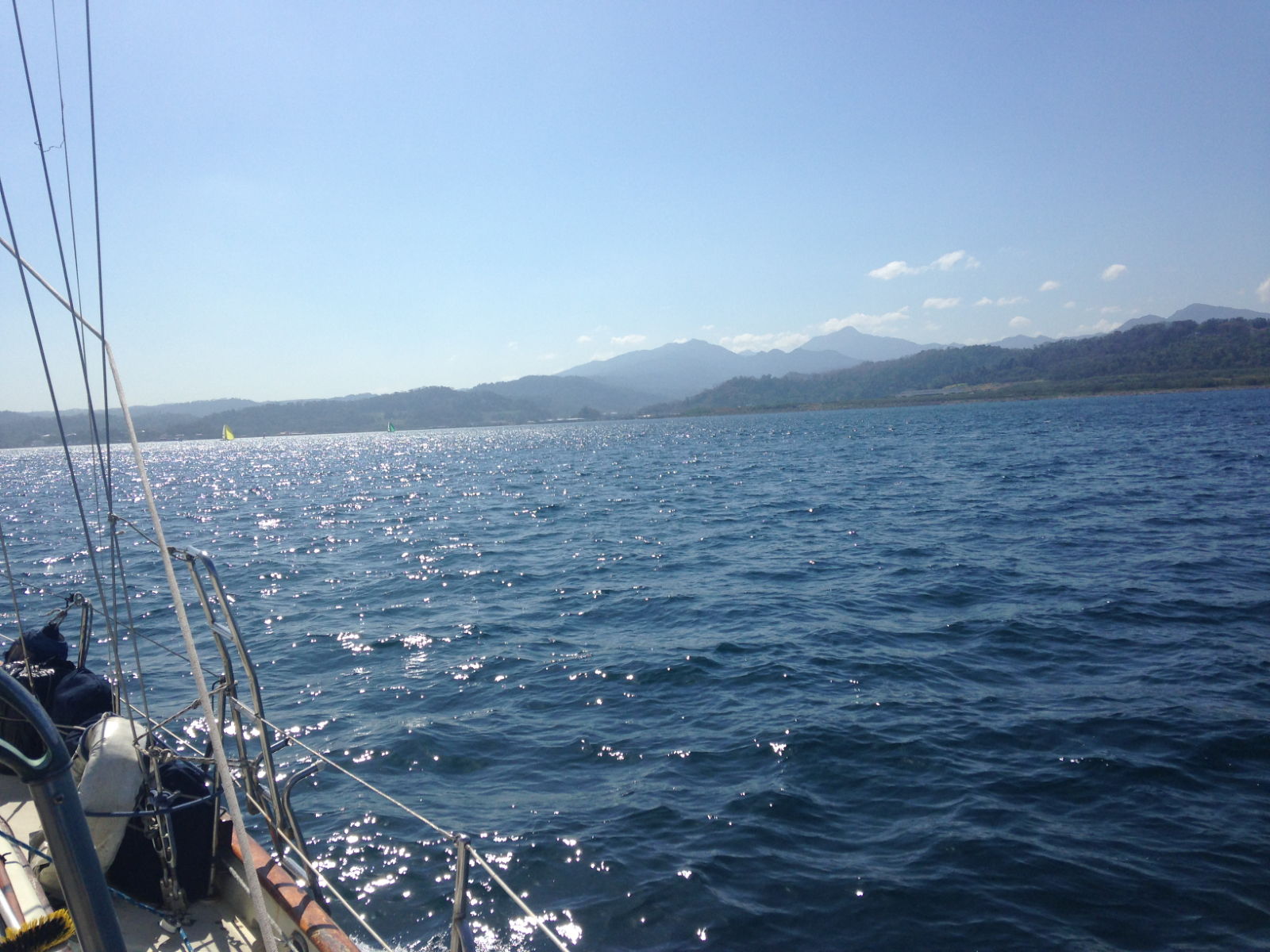
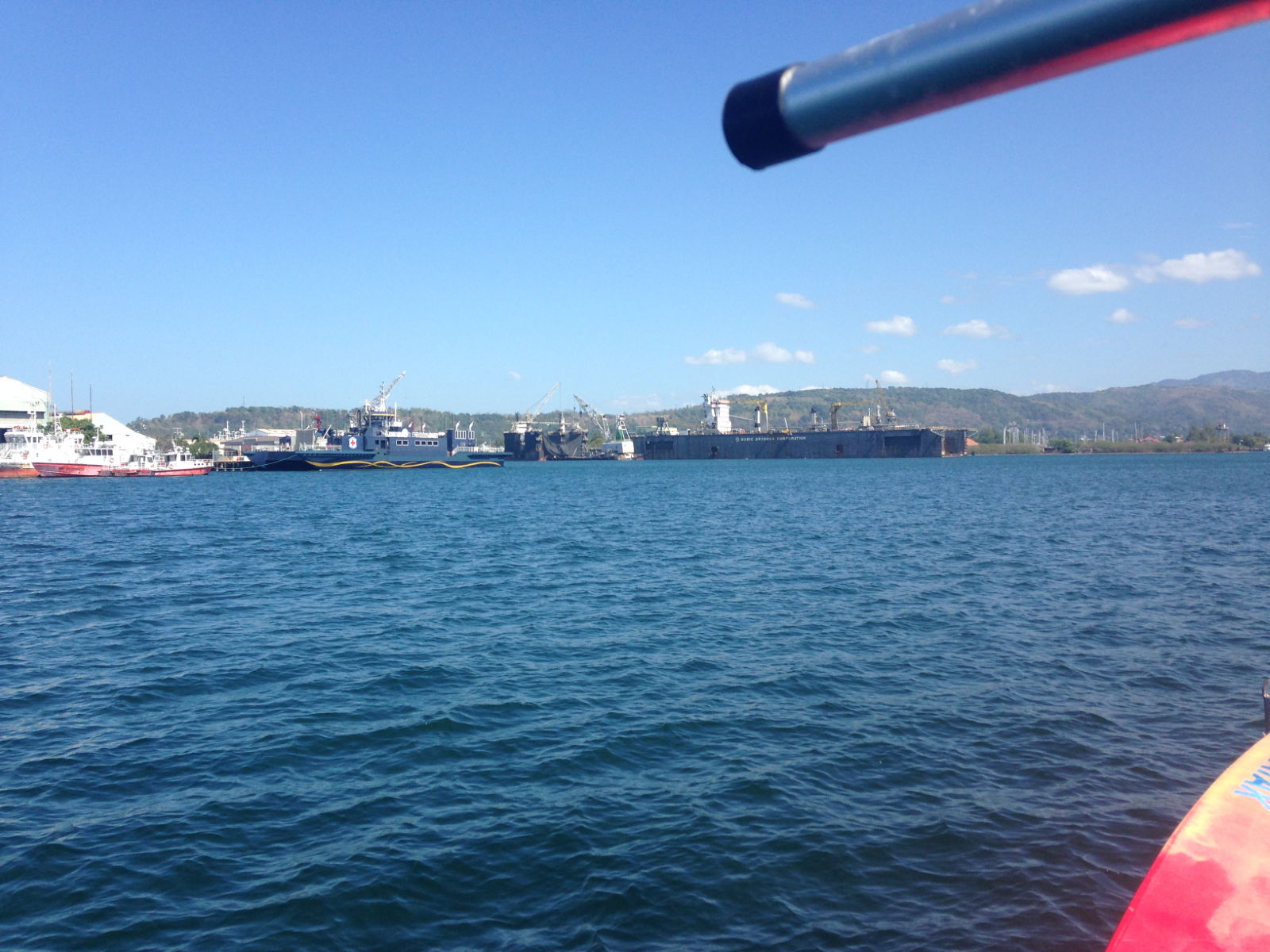

Both the marinas Paul called were full but one said we could anchor outside the yacht club. It soon became clear why they were full when a succession of yachts came motoring out of the marina with banners and flags displaying the name of another regatta. As Paul commented, we saw more yachts in an hour that morning than we’d seen in the whole of the Philippines. The spot outside the yacht club didn’t appeal to us and was too far away from where we wanted to be. We returned to the beach area that we’d noted as a possible place to stop and were delighted to be confronted with lots of little optimist boats with youngsters from a local sailing school having a whale of a time. They used our boat as a marker to go around, which made steering a bit tricky as there were quite a few of them. We were hoping to tie to one of the mooring buoys. A guy on a nearby boat, who Paul asked whether they were for public use wasn’t sure and suggested we just use one, then check with a man at the large bar/restaurant establishment on the shore. This time, I steered us towards the buoy, the sailing school gang still sticking perilously close to us. Paul hooked it and once secured to it, dinghied over to check if it was ok to stay there. He returned with the news that not only was it was fine for us to stay, it was free too.
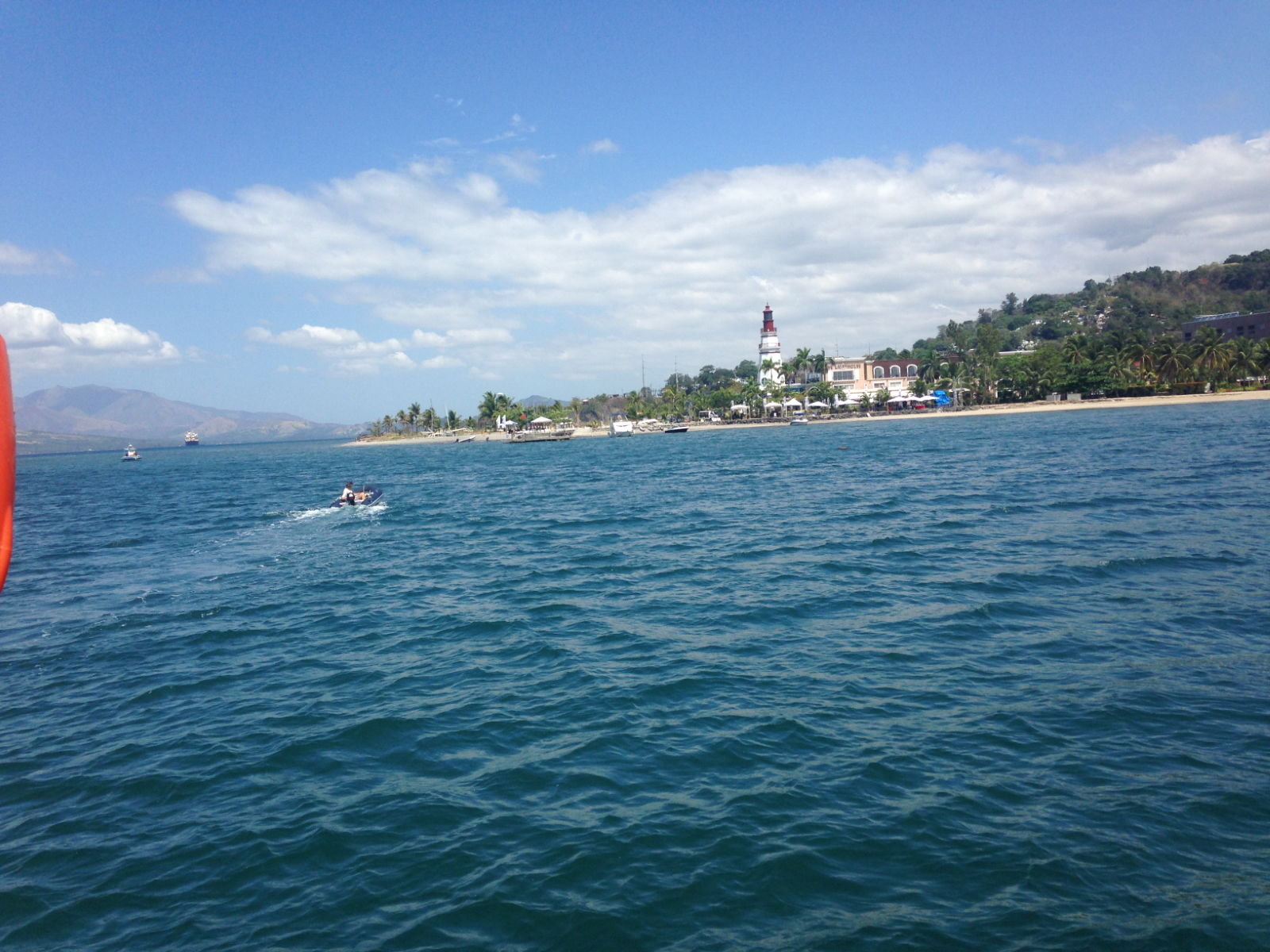
Researching Subic Bay online, one site referred to the wide range of American food on sale, apparently as a result of a US base situated there after the Second World War. The only hint of this we saw, however was a profusion of fast food joints. These diners were located behind the glitzy waterfront buildings and were part of a series of square, austere concrete complexes advertising ‘fries and steak’, ‘BBQ ribs’, ‘breakfast pancakes’ as well as the usual hot dogs, burgers and pizzas. This then, seemed to be the American fare mentioned online because we found little in the supermarkets that differed from standard products we’d become familiar with.

We were in the duty free area of Subic Bay so several outlets were advertising chocolate, cigarettes and alcohol as we strolled along in air heavy with humidity. Google maps showed us the way to the next town, Olongapo which was only a short distance away, but required us to cross what looked like a border patrol and I wondered if we should have brought our passports but no one stopped us. Olongapo was a busy, traffic-choked little town but we enjoyed ambling around it, and managed to find everything we needed to buy there.
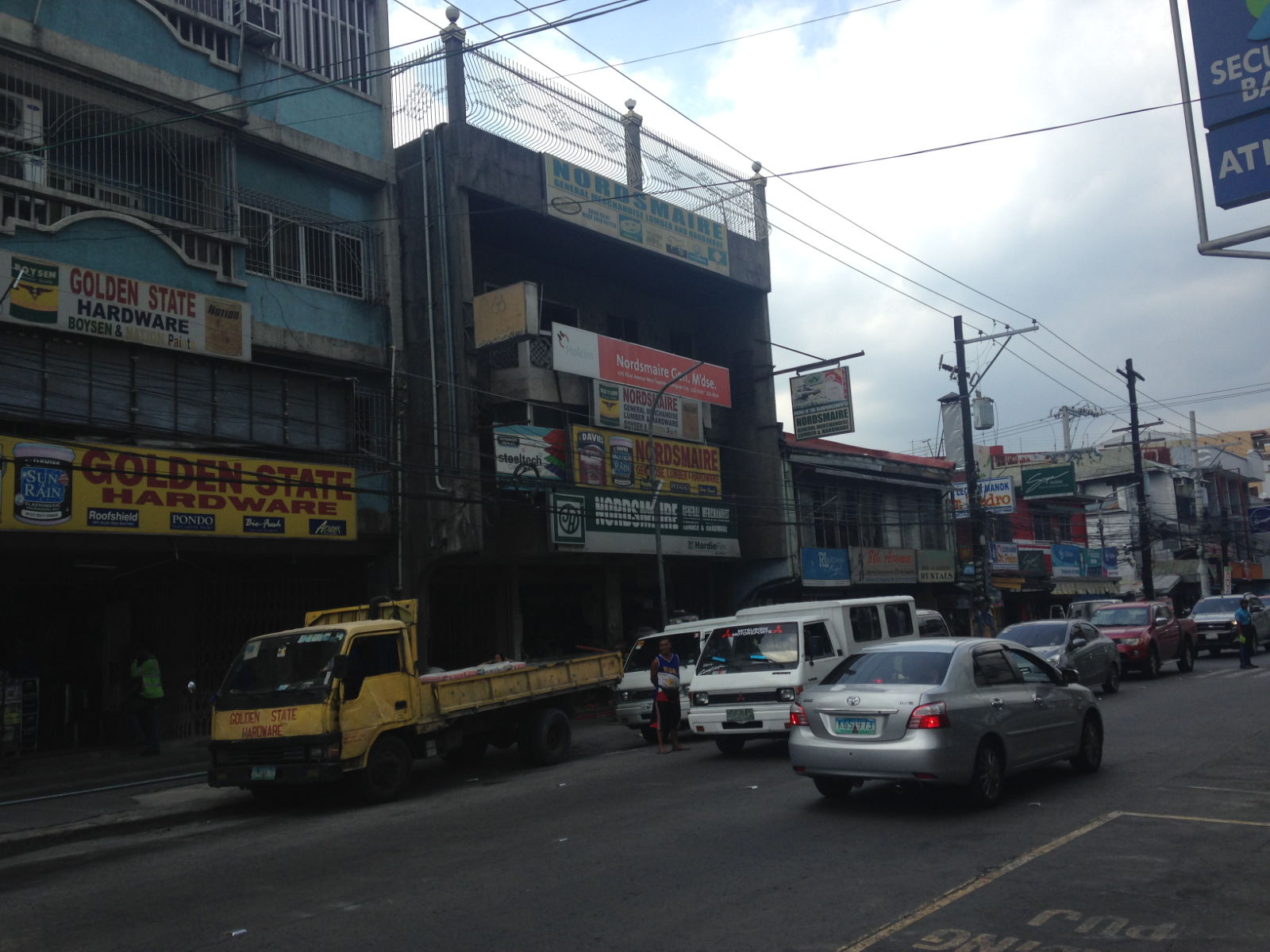
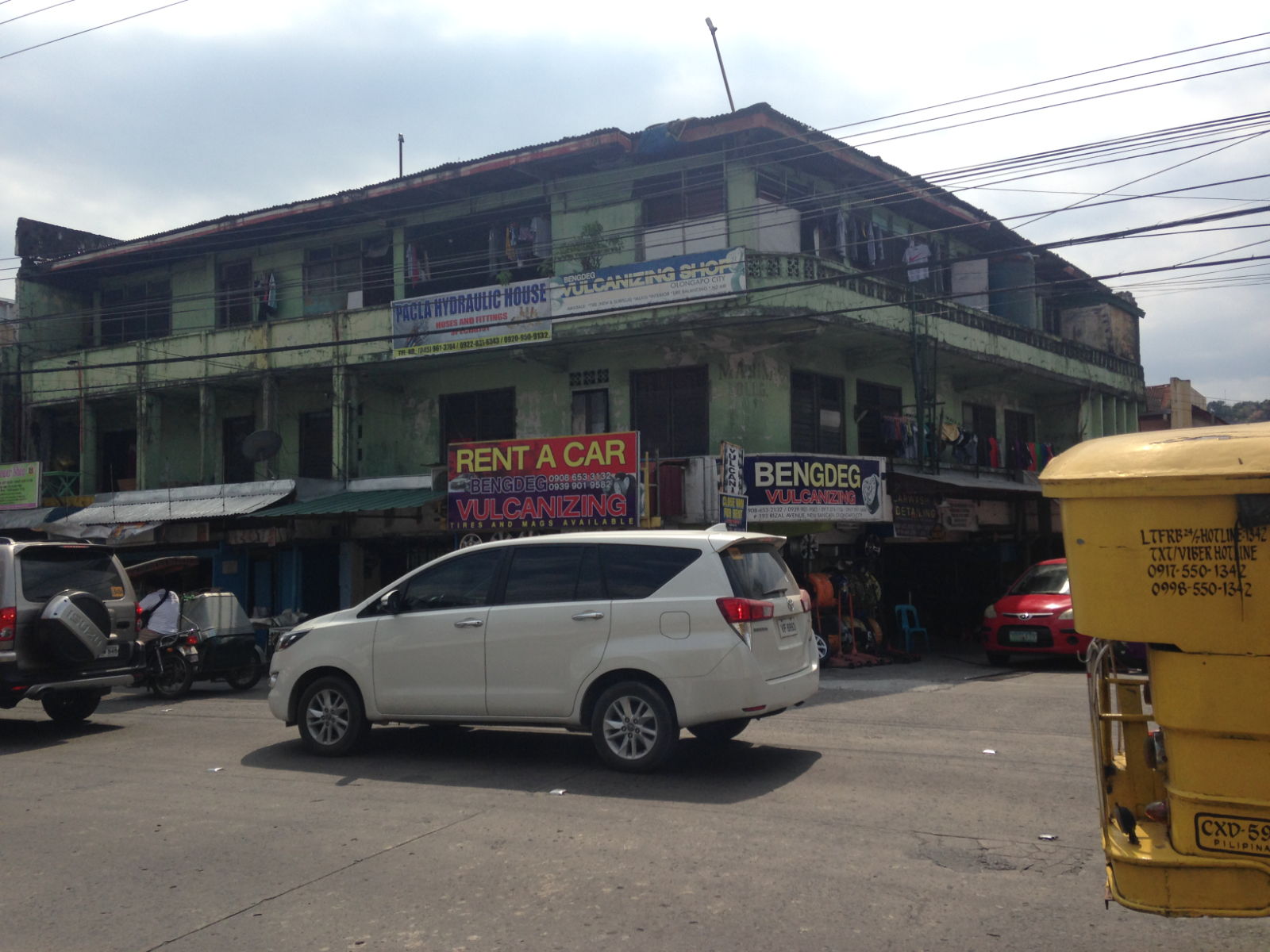
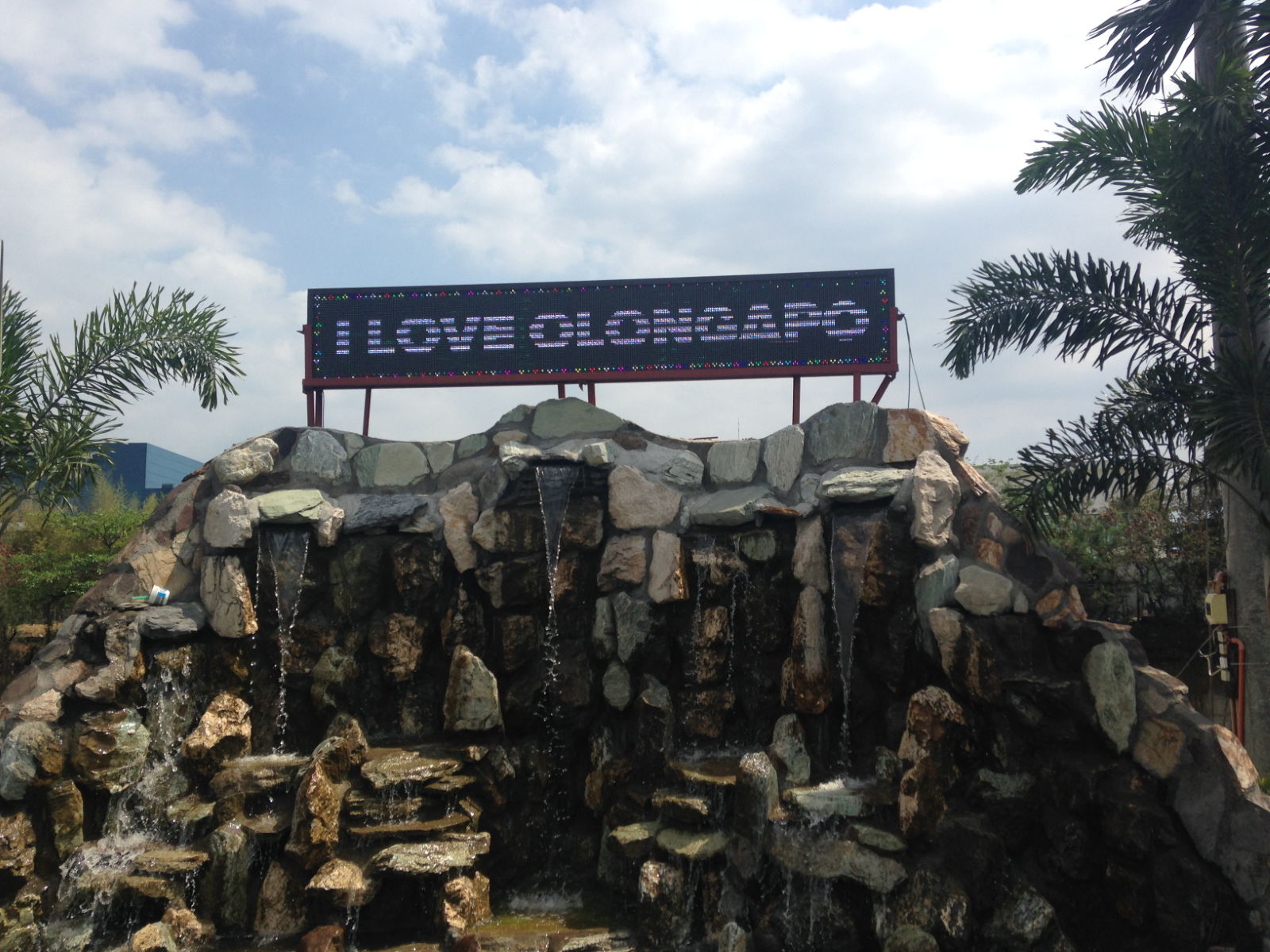

The book I’d been reading about prisoners of war on Palawan had revealed how much the Filipino people had respected and helped the Americans during World War 2, often risking or losing their own lives to do so. The plaque in the picture is just one of several memorials to them I came across in the Philippines. The Oryoku Maru was one of the so called ‘hell ships’ used to transport prisoners and conditions on board were unbearably hard for the men crammed into the holds. It’s hard to read the inscription on the picture but this Wikipedia extract provides an adequate explanation of what happened.
The Oryoku Maru left Manila on December 13, 1944, with 1,620 prisoners of war (including 1,556 American, 50 British and Dutch, 7 Czech, 4 Norwegians and several other nationalities) packed in the holds, and 1,900 Japanese civilians and military personnel in the cabins. As she neared the naval base at Olongapo in Subic Bay, US Navy planes from the USS Hornet attacked the unmarked ship, causing it to sink on December 15. About 270 died aboard ship. Some died from suffocation or dehydration. Others were killed in the attack, drowned or were shot while escaping the ship as it sunk in Subic Bay where the ‘Hell Ship Memorial’ is located. A colonel, in his official report, wrote:
- Many men lost their minds and crawled about in the absolute darkness armed with knives, attempting to kill people in order to drink their blood or armed with canteens filled with urine and swinging them in the dark. The hold was so crowded and everyone so interlocked with one another that the only movement possible was over the heads and bodies of others.
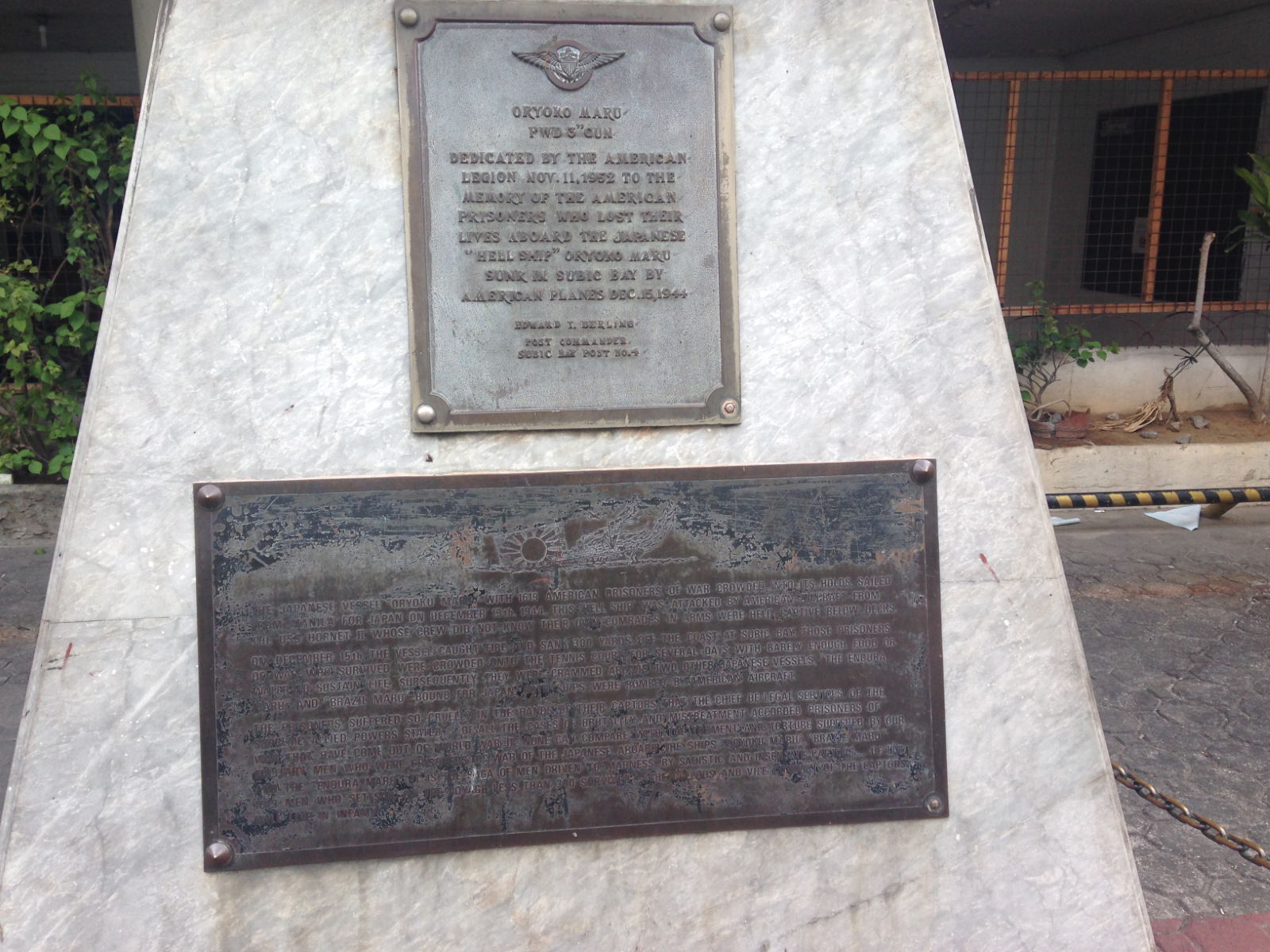
In the evening, back in Subic Bay and stocked up with soft drinks, wine and chocolate, we went out to find somewhere to eat. The bars and restaurants that lined the waterfront vied for custom with the usual food and entertainment enticements advertised outside, but the one that appealed (to me at least) had a live band on a stage. The singers and musicians were performing western pop songs Filipino style, and the dancers were great. We sat outside on what was a very humid night and watched while eating tofu (for me) and fish (for Paul) meals before heading back to plan the next passage.
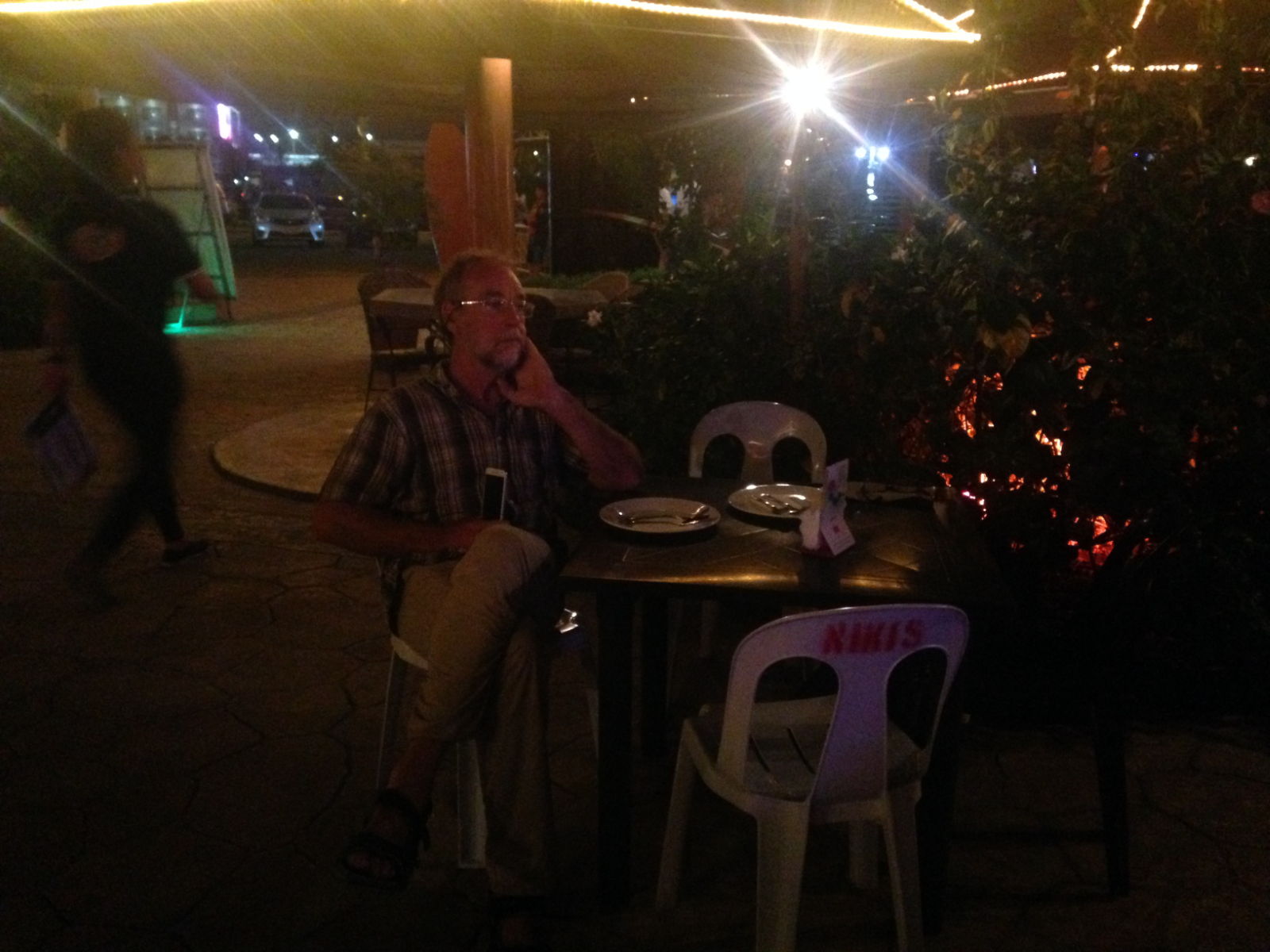
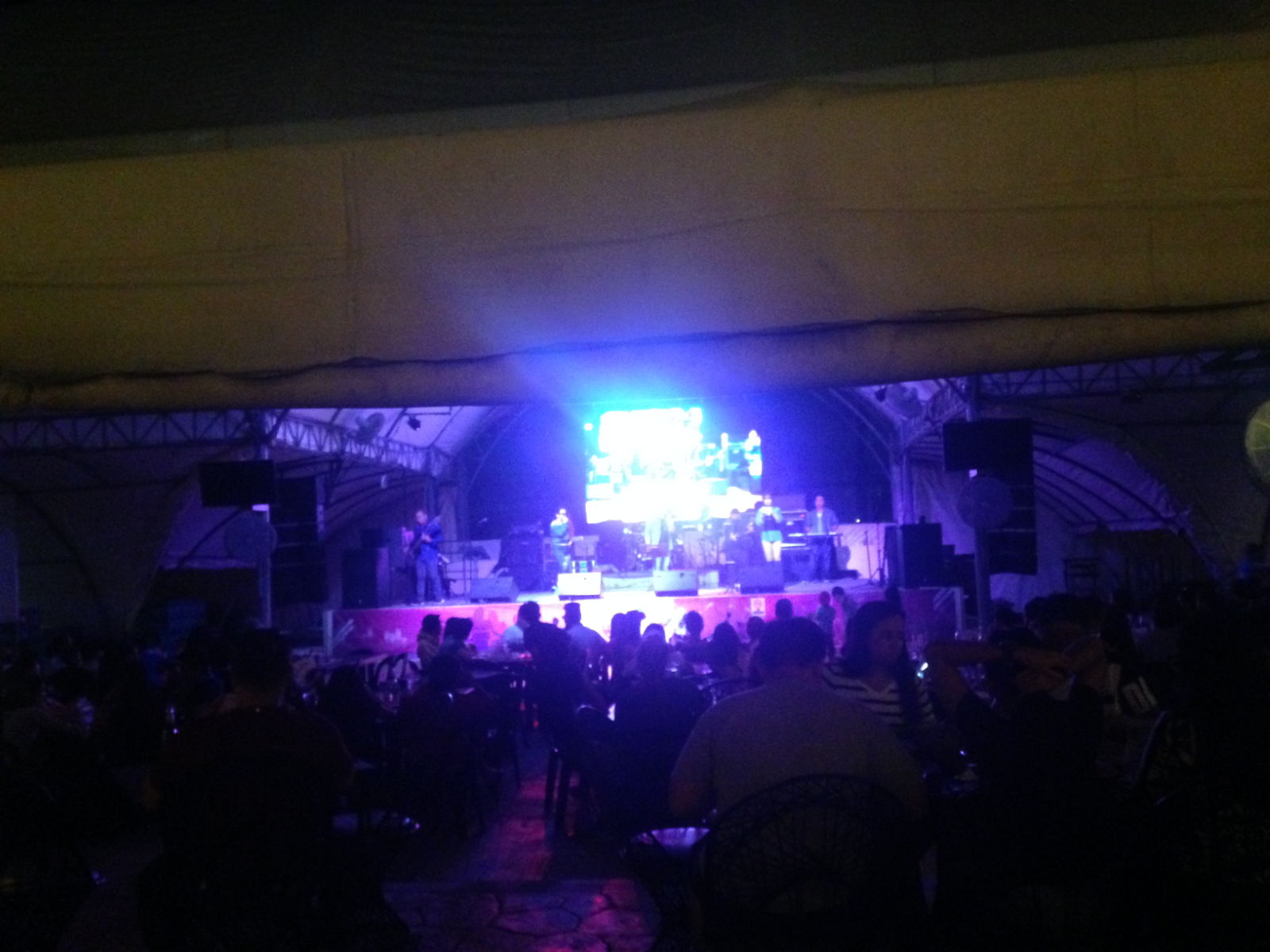
Paul had worked long and hard on the schedule we’d be keeping to for the journey to Japan and had planned it so that we wouldn’t have too many night passages. The next part began this morning (7th April) with a 6 30 departure for an anchorage at Palanginan, north Philippines. The trip took 10 hours but we were able to do most of it under sail and anchored at 5pm in a bay that proved to be a lot busier than Paul expected. No less than three bancas came up to us before we’d even got the anchor set. The first one dropped their anchor very close to us and I couldn’t stop myself asking ‘do you think they could be pirates?’ This isn’t a foreign tourist destination so they were just curious to see us and the crew on most of the boats we saw gave us welcoming smiles and waves.
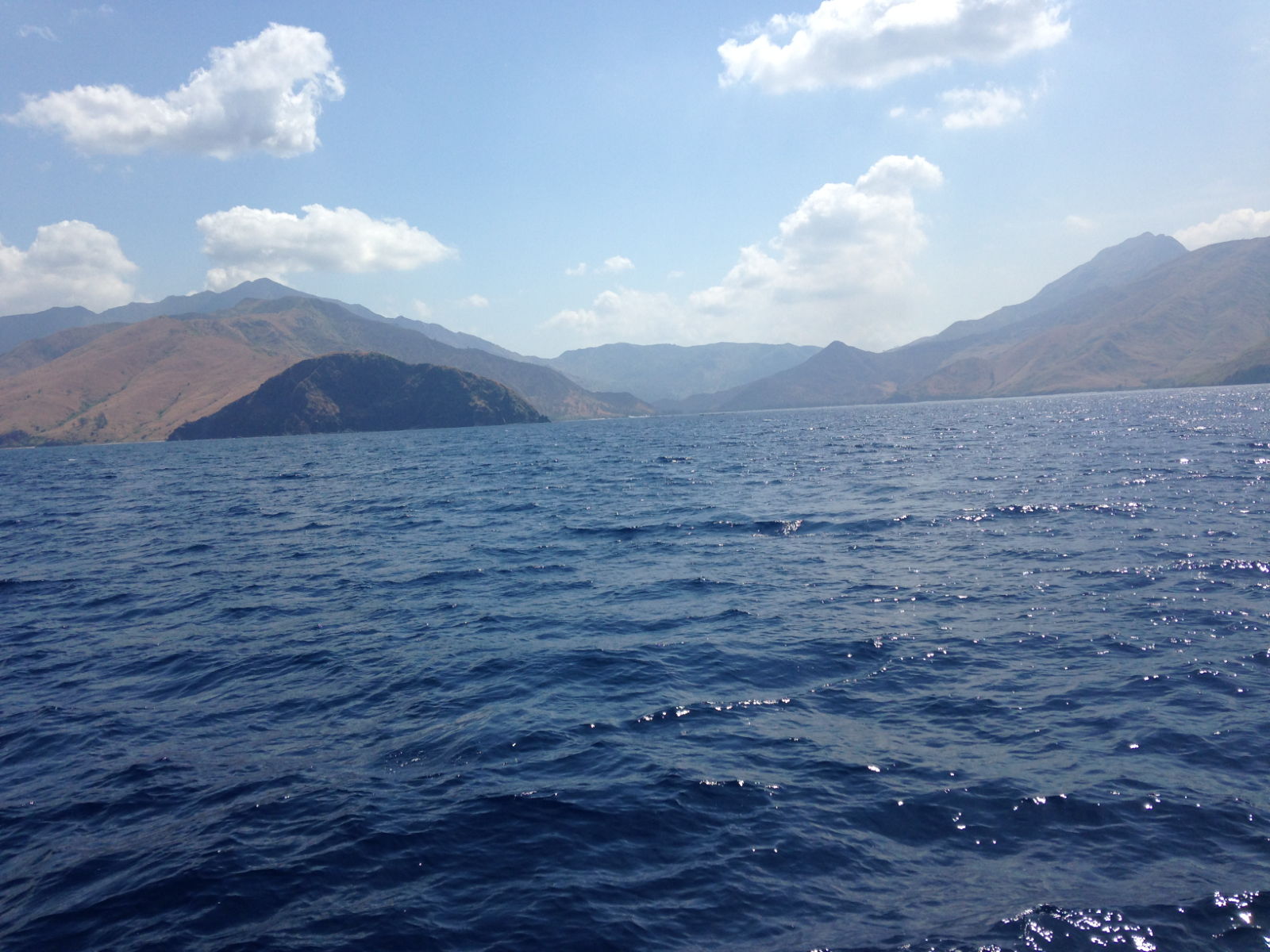
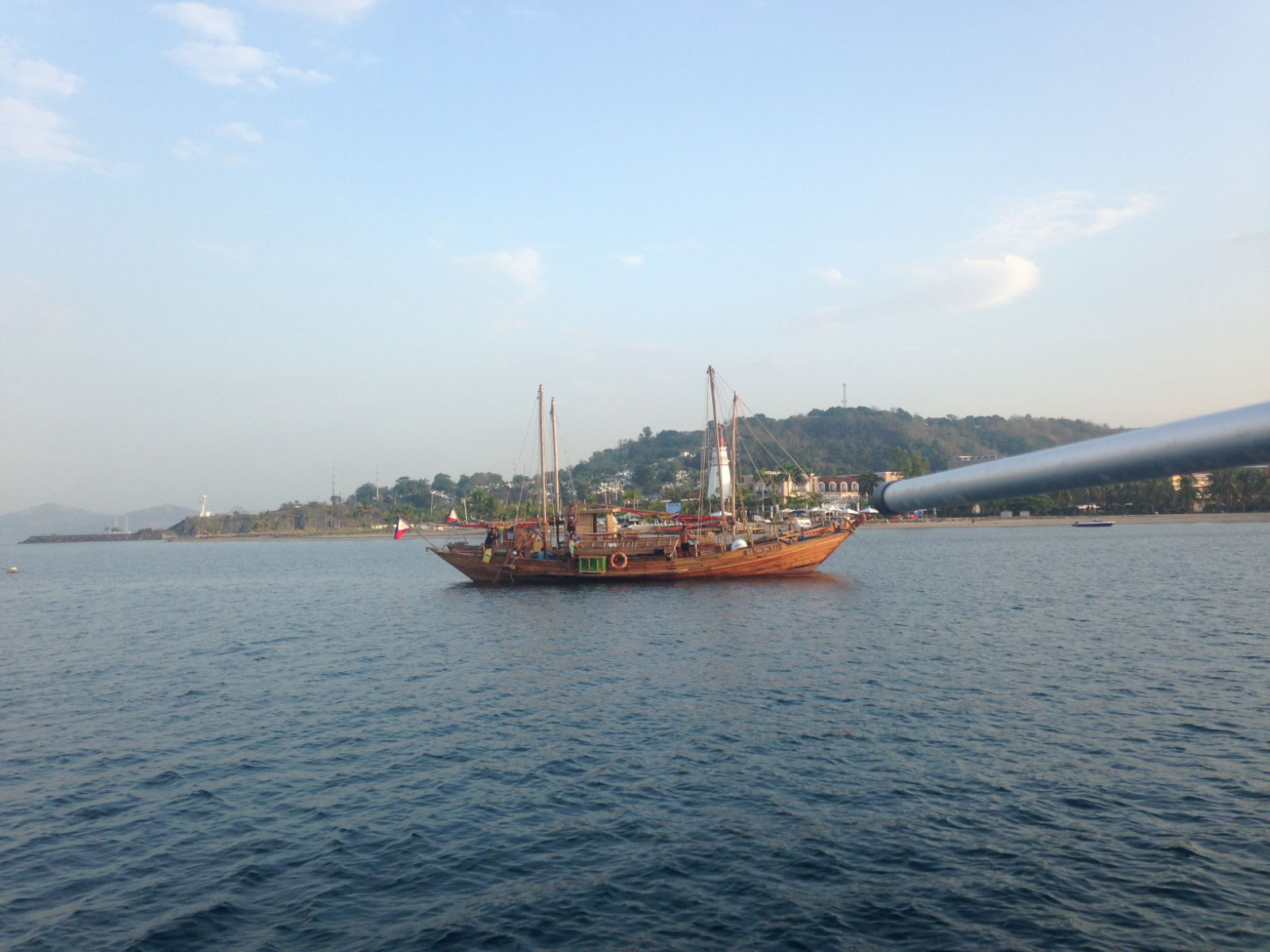

As darkness fell, fires were lit on the beach opposite and music began to boom out. We were beginning to get the idea that Filipino holidaymakers love to party. The music and the celebrating went on all through the night. When the flaky wifi connection let us look things up again we discovered we were opposite a place called ‘Lindamar By The Sea Resort’ on Iba Beach, a popular place for beach entertainment. At 6am the partying was as rowdy and lively as if it was midnight. At that early hour on a Sunday morning, besides the karaoke, music and dancing going on, we spotted swimmers, people playing beach volleyball, kayakers and motor boats departing for trips across the bay. It was as if all the benefits of the resort’s activities could be enjoyed at any time during a 24 hour period. We sat in the cockpit enjoying our morning coffee and a breakfast of delicious Filipino mangoes watching it all before we left for another night passage.

By the end of the morning, however the wind was pushing us along at such a speed, Paul thought we’d arrive at midnight! We alternated between port and starboard tacks all afternoon with no engine, so that the ‘zigzag’ route slowed us down sufficiently. Very few vessels at sea until the fishermen came out at twilight, and the usual ‘eagle-eye’ lookouts went into operation. This is a lot easier with the comforting light of a full moon but it was a half-moon that evening. Fishing boats don’t tend to use AIS and a few times, Paul had to shine a torch across the water separating us to alert them to the fact we were nearby, as had been done to us previously. Apart from that the night passage and on into the following day went well. The swell and the rolling prevented us from doing much activity. In my case, it creates a kind of lethargy where it’s too much effort staying upright to move from one end of the boat to the other. I did manage to cook a tofu stir fry in those conditions however, using my legs and back to pinion my body against the wooden galley corner as I cooked.

Late in the morning of Monday 9th April we were approaching San Fernando in heat and humidity that soaks you with sweat within minutes. A banca approached with a guy sporting some strange headgear (see pic below) who offered to sell us some fish. Paul declined but asked if he could take his picture, which he was happy to pose for. He also offered to guide us to San Fernando but Paul told him we could probably find it.
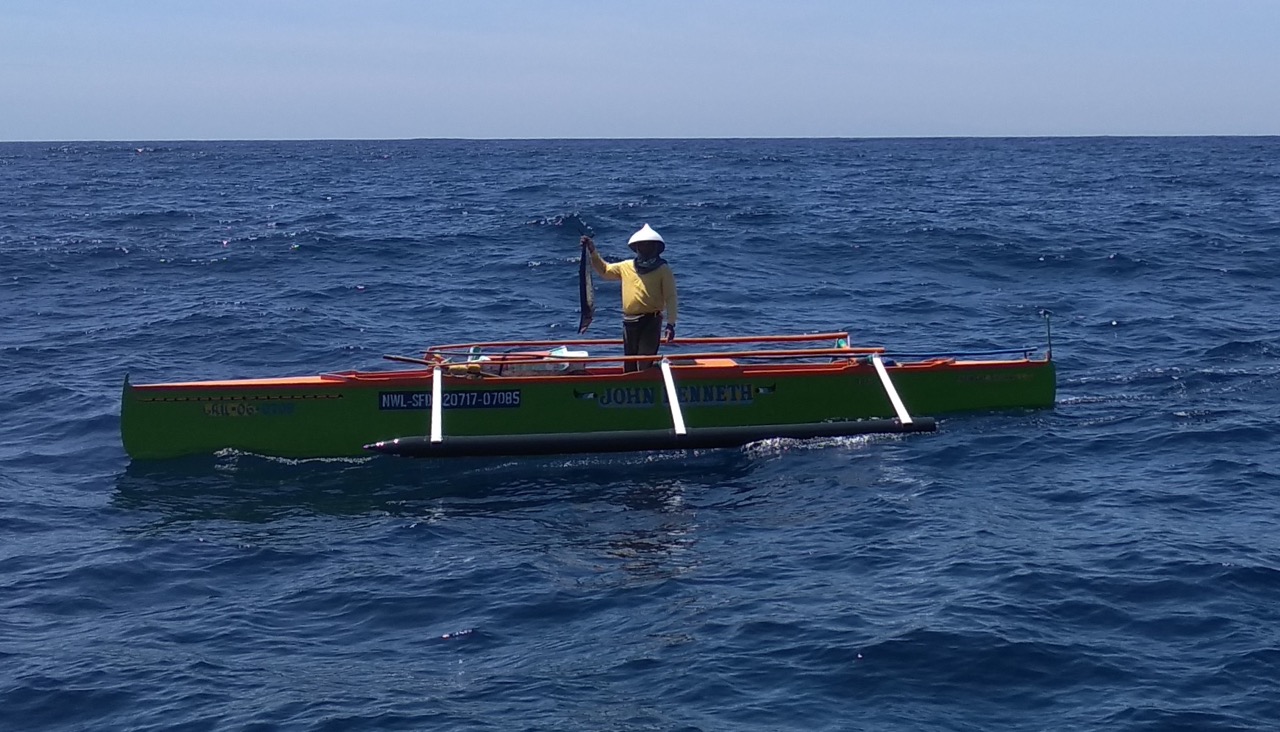
Another banca appeared shortly after we had anchored, with three guys on it this time. A family,consisting of dad and his two sons, they ended up being our personal assistants for the whole of our stay and the father was a huge help. After talking with Paul, he shot off in their boat, Zamorna, on a mission to get diesel and water for us and returned very quickly with it all.
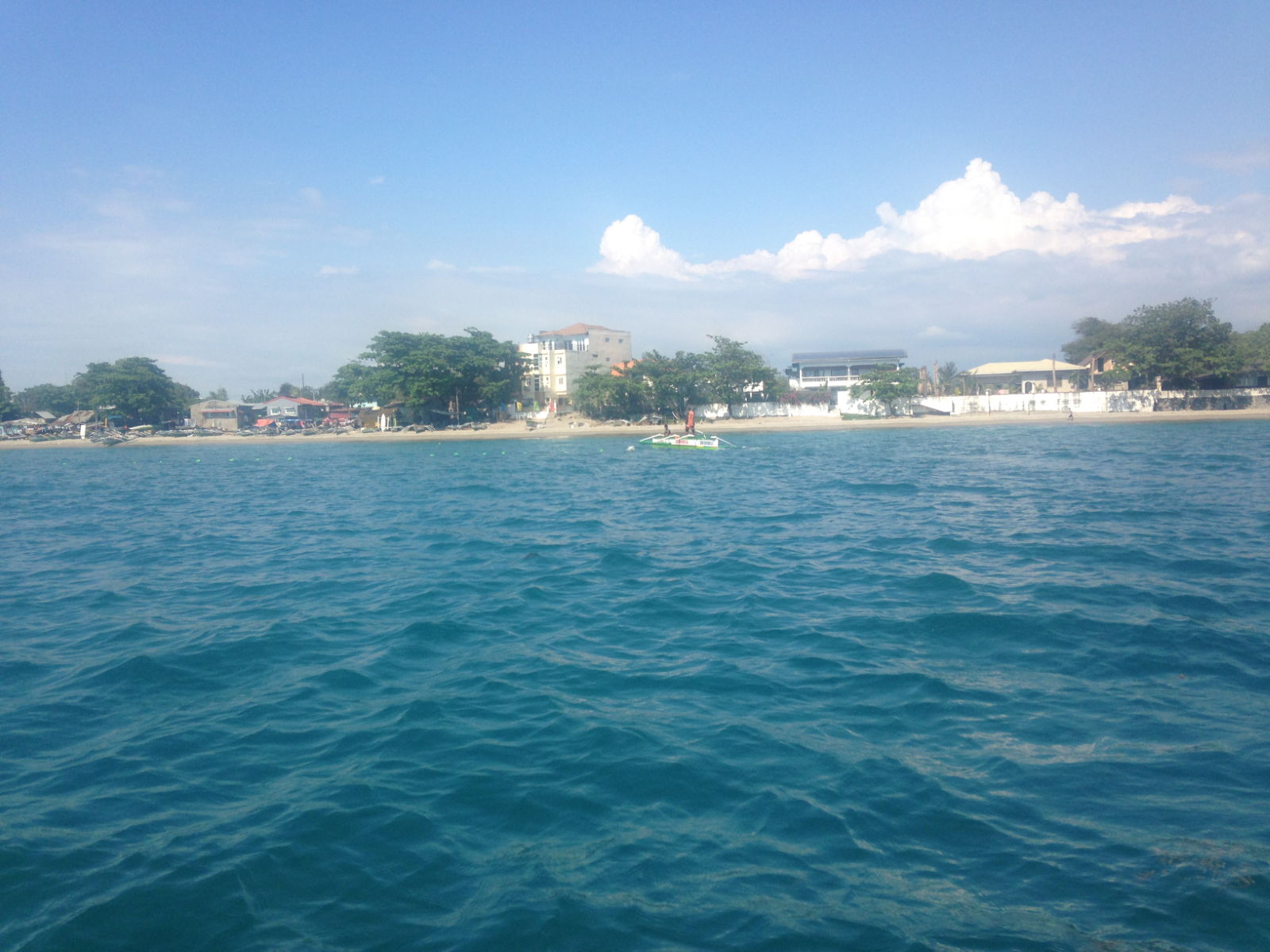
Once again, there was the ‘how much?’, ‘well, however much you think it was worth’ interaction so Paul gave generously. This might have been why they took it upon themselves to look after us so well because when we dinghied ashore later to check in, the same crew of three were there waiting to help us pull the dinghy onto the beach. No sooner had we secured it than dad ordered the boys to guard it while he led us up from the beach through the town’s fascinating backstreets. Here, we saw very basic living: rundown shacks, poor drainage, mud tracks instead of pavements, and goats, chickens, dogs and puppies mingling with the children outside the huts. Lots of people were around and though they stared at us unashamedly, they invariably smiled as our guide hustled us on through the narrow dusty lanes. Quite a few held their hands out for money, but even if we’d had a mind to give any, we wouldn’t have had time to. I would have loved to take a few surreptitious pictures but was afraid of being left behind. After a few minutes we were invited to wash our feet at the communal tap and we emerged from the village onto a patch of waste ground. This appeared to be the place for villagers to gather and socialise. It reminded me a little of areas at music festival venues. People were cooking on open fires while games of football and basketball were being played. Others were sat around chatting. It was lively, vibrant, rudimentary and brilliant.

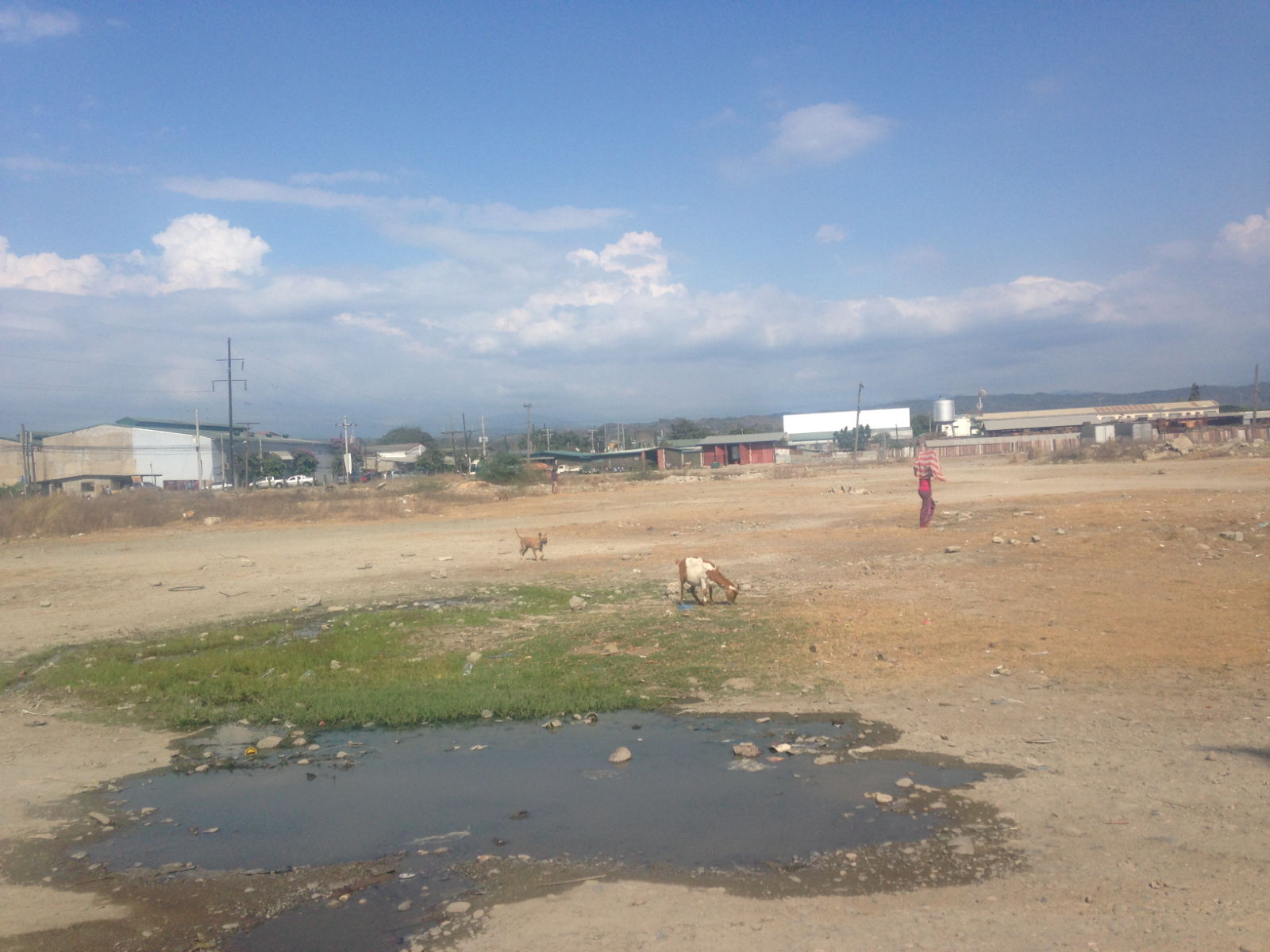

The heat had increased by now and I felt overcome by it after rushing through the village. I hoped the immigration place wasn’t too far away. Once we were on the main road, our man pointed us in the right direction and left us to it. Not far away there was a kiosk with an official looking man in it with whom Paul double-checked we were on the right road for immigration. We were, but today it was closed for a public holiday, he informed us apologetically. Rather than return to the boat we elected to walk on into town, but via the shady back streets out of the glaring sun. Google maps showed us the way and we had another fascinating walk away from the mainstream. You kind of get used to people staring. We do look conspicuous in our sun hats, and with phones out taking lots of pictures, not to mention Paul’s height. It’s very hard to convey the combination of all we saw, heard and smelled. There were cockerels crowing, trikes and motor bikes roaring along with horns honking, the smells of fried chicken and other unidentifiable aromas –some good, some not so good. We saw turkeys, dogs, cats, cockerels and goats in the run down roads and streets, and more dilapidated houses, and tiny shops with wire frontages. It wasn’t quite subsistence living but not far off it.

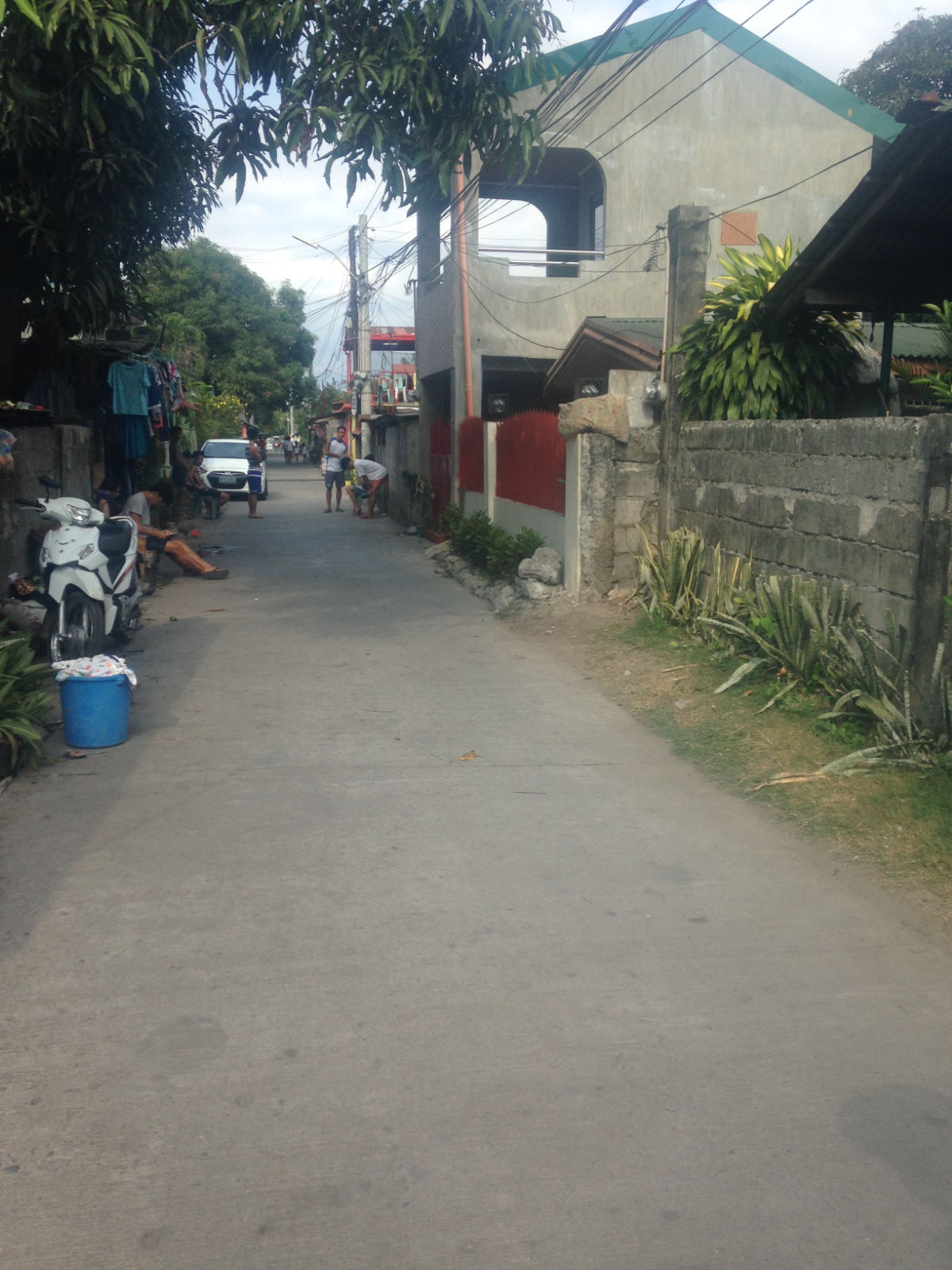

We stopped for a drink on the outskirts of town and sat at a table on a dusty roadside before walking on into the centre of San Fernando.
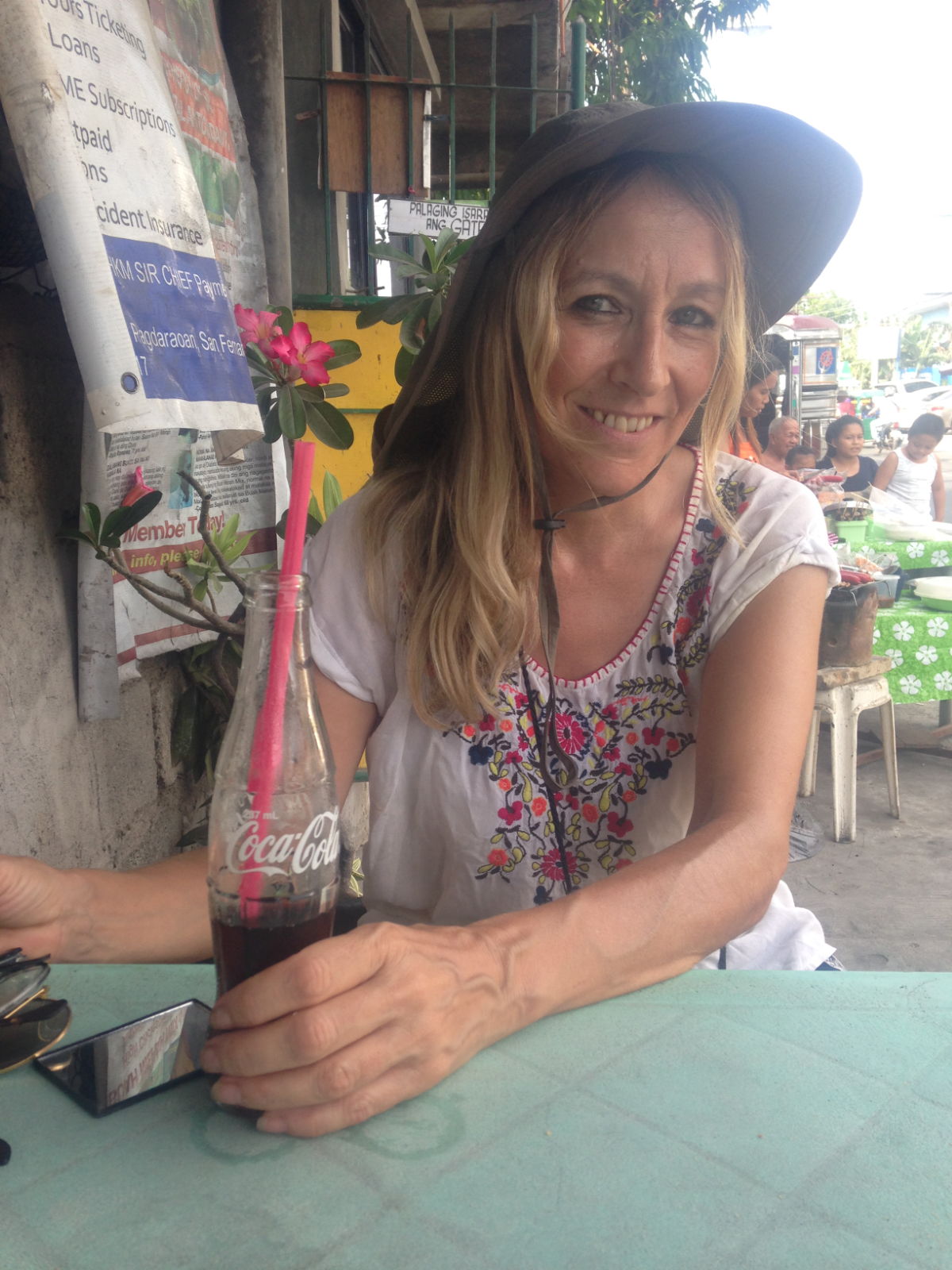

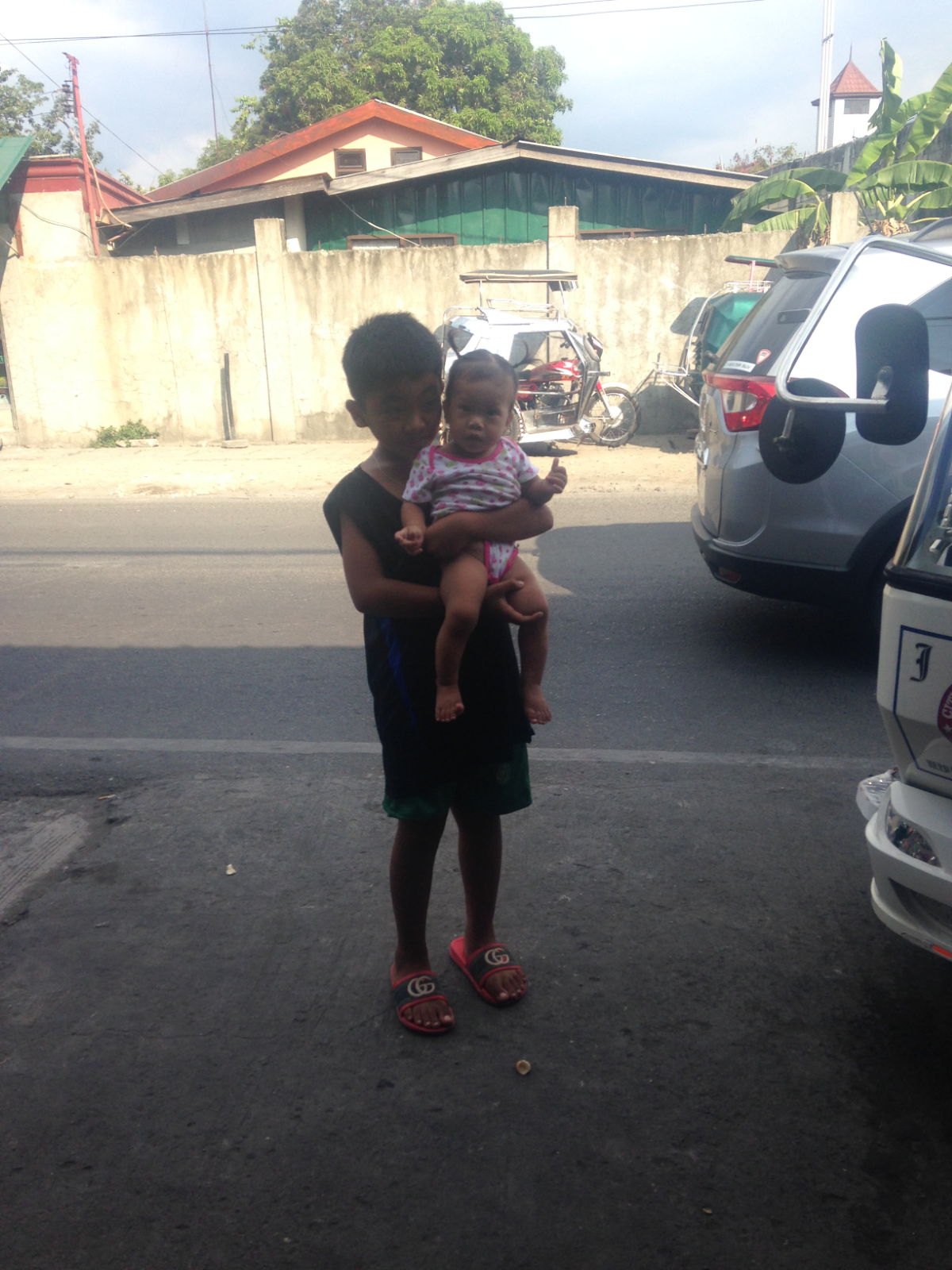
In a huge, old wooden building the market was located. We went there to top up our supply of bananas and mangoes. As we walked round, traders urged us to come to their stall by calling out such things as ‘yes sir’, ‘yes madam’, ‘have a look’, ‘you try’.
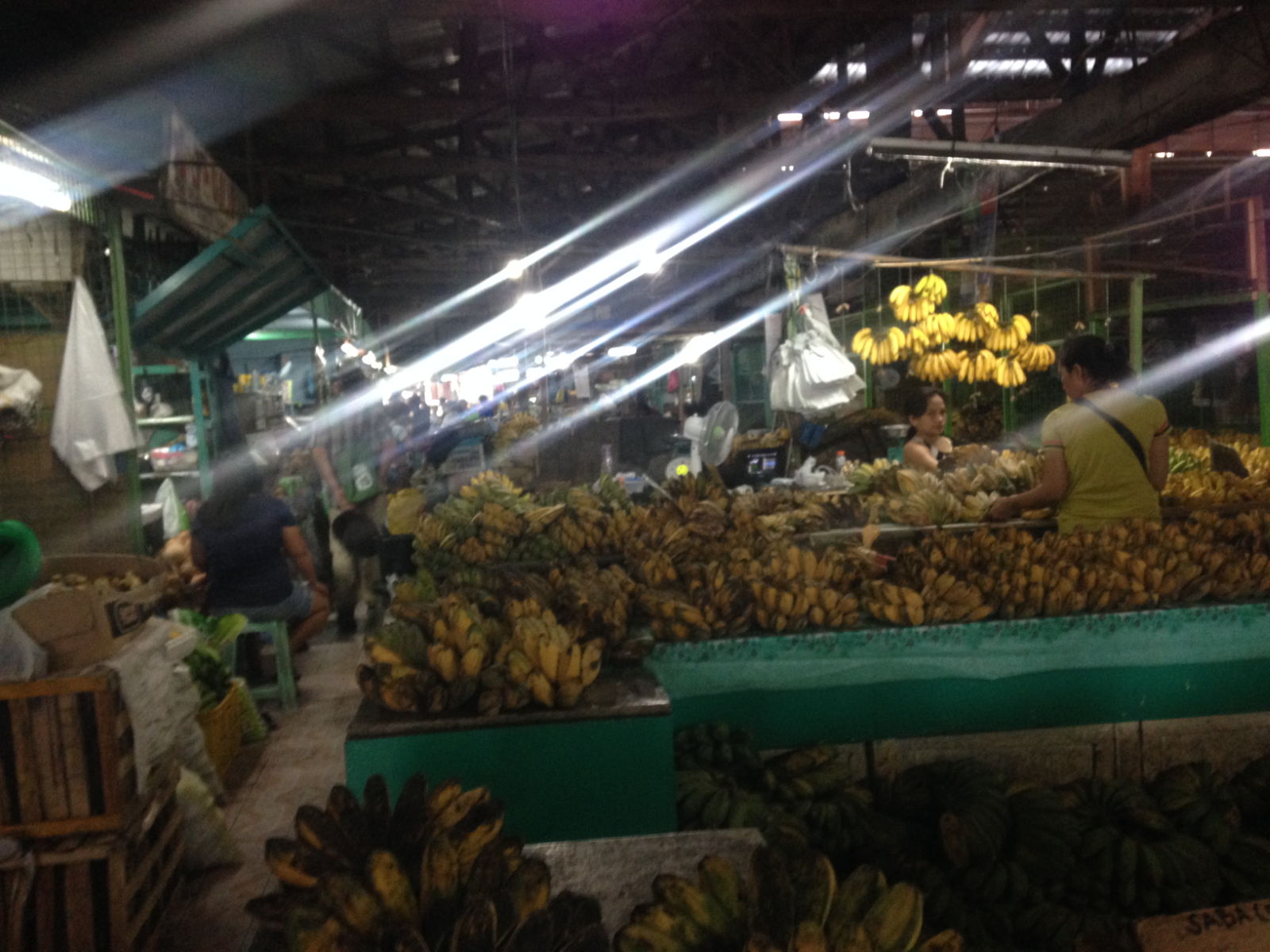


I was captivated by it all, despite feeling exhausted from a long walk in the heat. Arriving back on a trike I was amazed to see the two boys from Zamorna waiting for us on the waste ground outside the fishing village, where people were now settling in for the evening pastimes.
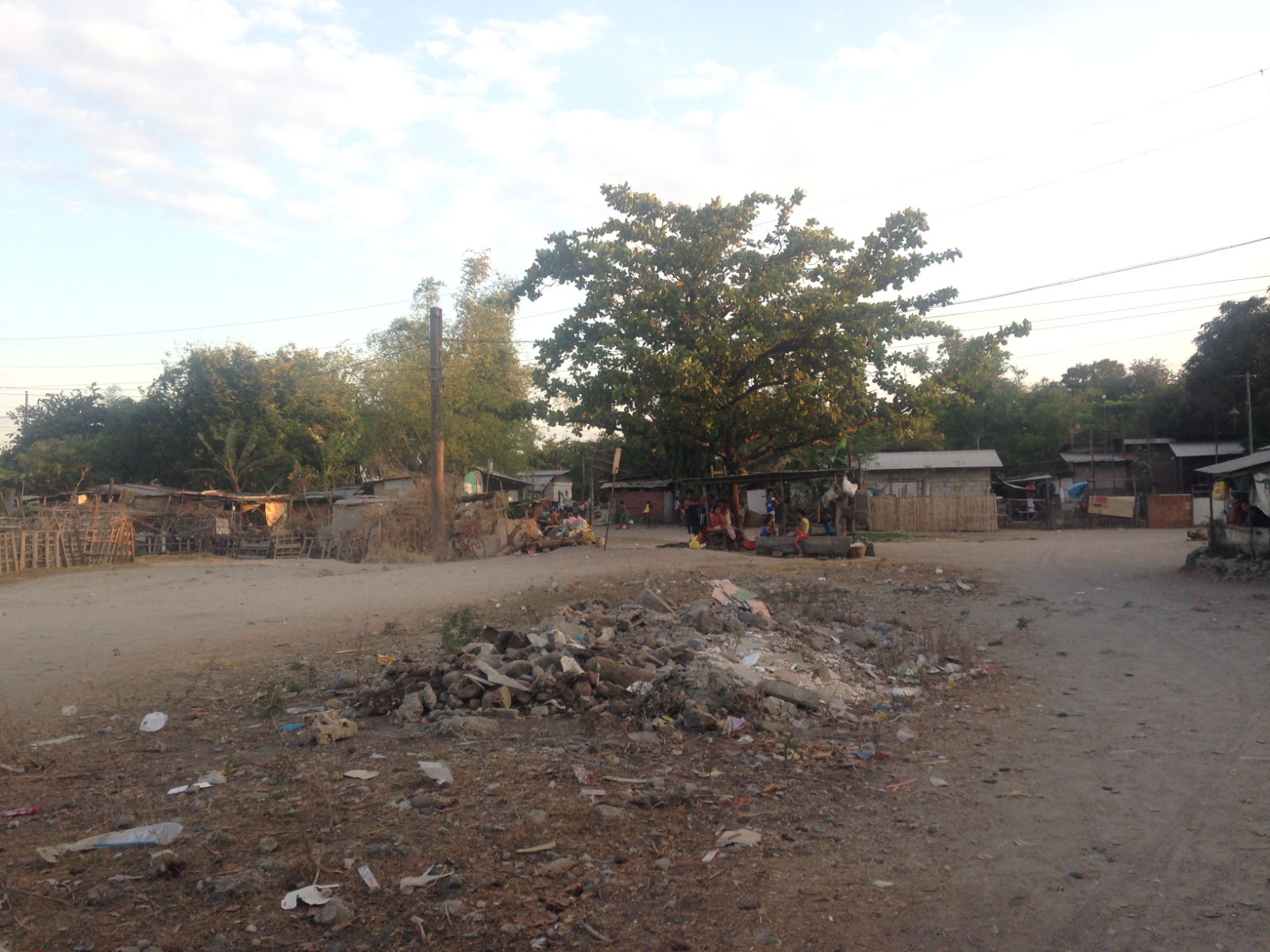


They were there to guide us back through the higgledy-piggledy lanes to our dinghy. Nice as this was of them, I’d been hoping for a more leisurely walk to have a closer look at the ramshackle houses but once again we were rushed through and almost bundled into the dinghy. Paul ordered some wood from the dad once they’d escorted us back to our boat.
The sounds of Cockerels crowing, and the barking and howling of dogs greeted me when I woke early the next morning. I went above to watch the beach come to life as the sun rose. It was already hot by 7 30. Paul gathered the papers and forms ready to take to the immigration building. We decided he’d go alone and I would wait for the delivery of the wood and more drinking water from our Zamorna guys. The wood was for fender boards which would be needed for when we’d be tying up against harbour walls in Japan. While Paul was away I labelled and stowed some canned food for our Pacific crossing. Any paper labels have to be removed because they could block up bilge pumps if the boat were to flood with water for any reason. Then they have to be sealed in plastic bags to prevent rusting. We were ready to leave by 5pm after grateful farewells to Zamorna. I steered us out into the path made by the sun’s afternoon rays on the water while Paul put the main and headsails up. We were bound for Japan in earnest now and there would be night passages and overnight anchorages for the next few days. We hoped to arrive in Ishigaki, our first port of call in Japan at the weekend.
